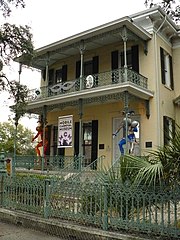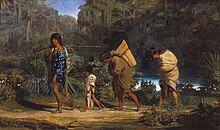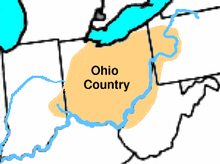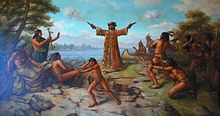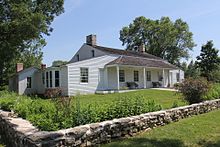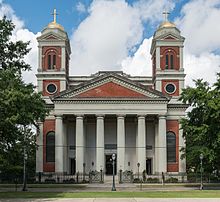French Louisianians
Pretty Creoles, pale-faced sewing girls, painted vice, big-headed and little-headed men, tall anatomies and short Falstaffs... a great country this is and make no mistake.
[8] Mardi Gras became of great importance as mystic societies began putting on masked parades with bands, floats, and horses after members attended grand balls.
In 1679, French explorer René-Robert Cavelier, Sieur de La Salle was the first European to cross into Indiana after reaching present-day South Bend at the St. Joseph River.
Some labored as engagés (indentured servants), i.e. "temporary semi-slaves"; they were required to remain in Louisiana for a length of time, fixed by the contract of service, to pay back the cost of passage and board.
[13] Under John Law and the Compagnie du Mississippi, efforts to increase the use of engagés in the colony were made, notably including German settlers whose contracts were absolved when the company went bankrupt in 1731.
(This practice was similar to events in 17th-century Quebec: about 800 filles du roi (daughters of the king) were recruited to immigrate to New France under the monetary sponsorship of Louis XIV.)
Indigenous nations offered essential support for the French: they ensured the survival of the New France's colonists, participated with them in the fur trade, and acted as guides in expeditions.
Many French colonists both admired and feared the military power of the Native Americans, though some governors from France scorned their culture and wanted to keep racial purity between the whites and Indigenous people.
However, by the 1750s in New France, the idea of the Native Americans became one of the "Noble Savage," that Indigenous people were spiritually pure and played an important role in the natural purity of the New World.
[19] In spite of some disagreements (some Indigenous people killed farmers' pigs, which devastated corn fields), and sometimes violent confrontations (Fox Wars, Natchez uprisings, and expeditions against the Chicachas), the relationship with the Native Americans was relatively good in Louisiana.
[26][27] The slaves brought with them their cultural practices, languages, and religious beliefs rooted in spirit and ancestor worship, as well as Roman Catholic Christianity—all of which were key elements of Louisiana Voodoo.
[21] In addition, in the early nineteenth century, many Saint-Domingue Creoles also settled in Louisiana, both free people of color and slaves, following the Haitian Revolution, contributing to the Voodoo tradition of the state.
The evacuation of Saint-Domingue and lately that of the island of Cuba, coupled with the immigration of the people from the East Coast, have tripled in eight years the population of this rich colony, which has been elevated to the status of statehood by virtue of a governmental decree.
The history of the French language in Minnesota is closely linked with that of Canadian settlers, such as explorer Louis Hennepin and trapper Pierre Parrant, who contributed very early on to its use in the area.
As early as the mid-17th century, evidence shows the presence of French expeditions, settlements and villages in the region, in particular thanks to Frenchmen Pierre-Esprit Radisson and Médard des Groseilliers, who likely reached Minnesota in 1654 after exploring Wisconsin.
[38] In April 1699, French colonists established the first European settlement at Fort Maurepas (also known as Old Biloxi), built in the vicinity of present-day Ocean Springs on the Gulf Coast.
[45] The expedition journal reported:[44] In the meantime, the boats were actively engaged transporting the powder, guns, and ammunition, as well as the live stock, such as bulls, cows, hogs, fowls, turkeys, etc.
Twelve guns were mounted.The best men were selected to remain at the fort,[44] including detachments of soldiers to place with the Canadians (the French also had a colony in what is now Quebec and along the upper Mississippi River) and workmen, and sailors to serve on the gunboats.
He carried a request from the French minister to the governor M. de Sauvolle, asking that Sagan be furnished with 24 pirogues and 100 Canadians to explore the Missouri River and its branches, a major tributary of the Mississippi that has its confluence at what later developed as Saint Louis.
[46] Later, during June–August 1722, the capital was moved again, by colonial governor Bienville, from Biloxi to deeper waters in the Mississippi River at a new inland harbor town named La Nouvelle-Orléans (New Orleans), built for the purpose during 1718–1722.
The strategic location of Natchez, on a bluff overlooking the Mississippi River, ensured that it would be a pivotal center of trade, commerce, and the interchange of ethnic Native American, European, and African cultures in the region; it held this position for two centuries after its founding.
Continued immigration of Canadien settlers and natives of Illinois Country, as well as a need for other resources resulted in some founders establishing Sainte-Geneviève in 1735 on the west side of the Mississippi in what is now Missouri.
By this time, the French had established several footholds along the upper Mississippi River such as Cahokia, Kaskaskia, St. Philippe, Nouvelle Chartres, Prairie du Rocher, and Ste.
[51] It is speculated that Native Americans may have already begun to process lead in the Upper Louisiana Valley by the 18th century, in part due to interaction with coureurs des bois and European expeditions.
The British Crown declared almost all the land between the Appalachian Mountains and the Mississippi River from Florida to Newfoundland a Native American territory called the Indian Reserve following the Royal Proclamation of 1763.
Genevieve and St. Louis assimilated more rapidly into English-speaking American society because of interaction with new settlers, while the inland mining communities remained isolated and maintained their French heritage.
Sainte-Geneviève has no more than a score of families which have remained definitely French.French did not fare far better in distant Vincennes where German immigration in the 1860s had severely weakened the French community and by 1930 there were only a small population of elderly francophones left.
[58] From 1934 to 1936, Joseph Médard Carrière made several trips to the Old Mines area to study the Missouri French dialect and to collect folktales from local conteurs.
[49] In 1977, Gerald L. Gold visited the community to document how movement away from family and child labor in lead and baryte mining coincided with the loss of Missouri French as a maternal language.
Even so, French traders continued to work in the region after the war, and some, beginning with Charles de Langlade in 1764, settled in Wisconsin permanently, rather than returning to British-controlled Canada.



